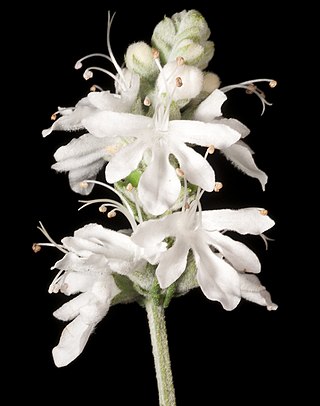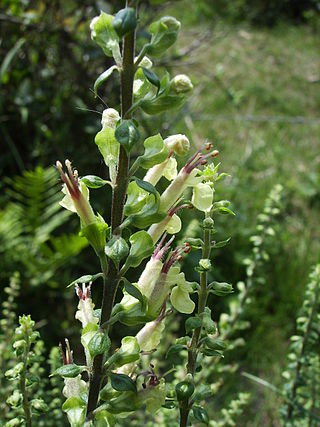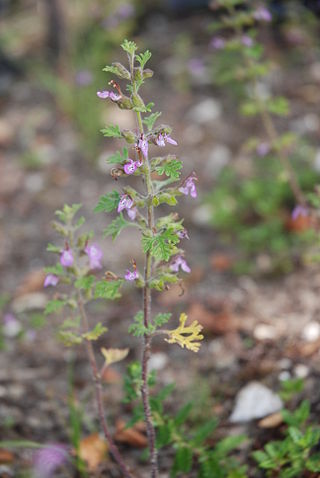
The Lamiaceae or Labiatae are a family of flowering plants commonly known as the mint, deadnettle, or sage family. Many of the plants are aromatic in all parts and include widely used culinary herbs like basil, mint, rosemary, sage, savory, marjoram, oregano, hyssop, thyme, lavender, and perilla, as well as other medicinal herbs such as catnip, salvia, bee balm, wild dagga, and oriental motherwort. Some species are shrubs, trees, or, rarely, vines. Many members of the family are widely cultivated, not only for their aromatic qualities, but also their ease of cultivation, since they are readily propagated by stem cuttings. Besides those grown for their edible leaves, some are grown for decorative foliage. Others are grown for seed, such as Salvia hispanica (chia), or for their edible tubers, such as Plectranthus edulis, Plectranthus esculentus, Plectranthus rotundifolius, and Stachys affinis. Many are also grown ornamentally, notably coleus, Plectranthus, and many Salvia species and hybrids.

Teucrium is a cosmopolitan genus of flowering plants in the mint family Lamiaceae, commonly known as germanders. Plants in this genus are perennial herbs or shrubs, with branches that are more or less square in cross-section, leaves arranged in opposite pairs, and flowers arranged in thyrses, the corolla with mostly white to cream-coloured, lobed petals.

Lake Ichkeul is a lake in northern Tunisia, located 20 kilometres to Bizerte, the northernmost city in Africa on the Mediterranean Sea. The lake and wetlands of Ichkeul National Park are an important stopping-over point for hundreds of thousands of migrating birds each year. Among the lake's visitors are ducks, geese, storks, and pink flamingoes. Dam construction on the lake's feeder rivers has produced major changes to the ecological balance of the lake and wetlands.

Teucrium scorodonia, common name the woodland germander or wood sage, is a species of flowering plant in the genus Teucrium of the family Lamiaceae. It is native to Western Europe and Tunisia, but cultivated in many places as an ornamental plant in gardens, and naturalized in several regions.

Teucrium marum, commonly known as cat thyme or kitty crack, is a species of germander. Its small, oval leaves give it a thyme-like appearance, but the musty scent is quite unlike the delicate aroma of thyme. Cat thyme is a mounding, tender perennial with grey-green leaves tipped by fragrant pink flowers in summer.

Teucrium chamaedrys, the wall germander, is a species of plant native to the Mediterranean regions of Europe and North Africa, and the Middle East as far as Iran. It is used as an ornamental.

Teucrium fruticans is a species of flowering plant in the mint family Lamiaceae, native to the western and central Mediterranean. Growing to 1 m (3 ft) tall by 4 m (13 ft) wide, it is a spreading evergreen shrub with arching velvety white shoots, glossy aromatic leaves and pale blue flowers in summer.

Apigetrin is a chemical compound that can be found in dandelion coffee and in Teucrium gnaphalodes.

Cynaroside is a flavone, a flavonoid-like chemical compound. It is a 7-O-glucoside of luteolin.

Coleophora auricella is a moth of the family Coleophoridae. It is found from Germany and Poland to Spain, Italy and Romania. It has also been recorded from southern Russia.

Teucrium botrys, the cutleaf germander or cut-leaved germander is a low to short downy annual, sometimes biennial, plant. It was noted by Carl Linnaeus in 1753 and is classified as part of the genus Teucrium in the family Lamiaceae. It has oval, but deeply cut leaves, which appear almost pinnate in form. Its flowers are two-lipped but with the upper lip diminutive. They are pink to purple and form from the stem at the base of the leaves, in whorls. It is in flower in the northern hemisphere from June to October. It prefers limy soils and bare stony ground. It is native to Western Europe, especially France and Germany. It has been introduced into north-eastern North America.

Scotopteryx bipunctaria, also known as the chalk carpet, is a moth in the family Geometridae. The species was first described by Michael Denis and Ignaz Schiffermüller in 1775. It is found from Morocco and Spain through western and central Europe and Great Britain to the Ural. In the north it is found up to the Baltic region and in the south its range extends over Italy and the Balkan Peninsula up to the Black Sea and Caspian Sea.

Teucrium racemosum, also commonly referred to as either the grey germander or forest germander, is a species of flowering plant in the family Lamiaceae. It is endemic to Australia and is found in all mainland states, the Northern Territory and the Australian Capital Territory. It grows in floodplains, dry lake beds and open woodlands. A perennial herb, it has four-sided, densely hairy stems, narrow egg-shaped leaves, and white flowers usually arranged singly in leaf axils. It grows to be between 15 and 40 cm tall.

Veronica austriaca, the broadleaf speedwell, large speedwell, Austrian speedwell, or saw-leaved speedwell, is a species of flowering plant in the plantain family Plantaginaceae, native to northern temperate Europe. Growing to 90 cm (35 in) tall by 60 cm (24 in) broad, it is a mound-forming herbaceous perennial, with deeply toothed leaves and erect spikes of bright blue flowers throughout summer.

Cirsilineol is a bioactive flavone isolated from Artemisia and from Teucrium gnaphalodes.

Veronicastroside is a flavone, a type of flavonoid. It is the 7-O-neohesperidoside of luteolin. It can be found in Veronicastrum sibiricum var. japonicum and in Teucrium gnaphalodes.

Teucrium gnaphalodes is a plant species in the genus Teucrium. It is endemic to the Iberian Peninsula and grows at altitudes between 200 and 1500 m. It flowers from March to July.

Ledol is a poisonous sesquiterpene that can cause cramps, paralysis, and delirium. Caucasian peasants used Rhododendron plants for these effects in shamanistic rituals.

Teucrium canadense, commonly known as Canada germander, American germander, or wood sage, is a perennial herb in the family Lamiaceae. It is native to North America where it is found across the contiguous states of the United States and in much of Canada.

Teucrium junceum is a species of flowering plant in the family Lamiaceae, and is endemic to eastern Australia. It is a scrambling, openly-branched shrub, with small leaves, white flowers and orange to red fruit.




















